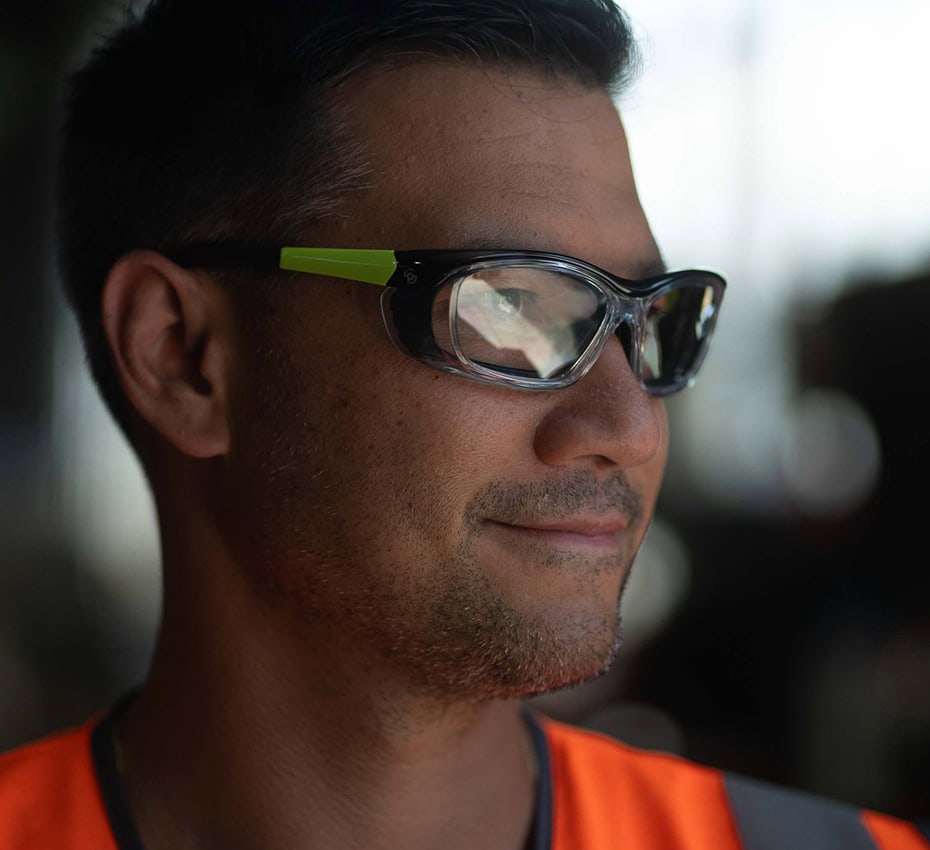- Safety Glasses
- Sports
- Sunglasses
- Eyeglasses
- Safety Products
- Accessories
ANSI Z87.1 is the USA safety standard created by the American National Standards Institute (ANSI) for protective eyewear. It ensures that glasses, goggles, and face shields meet specific impact and safety requirements to protect your eyes in hazardous environments.

Lenses and frames must pass high-mass and high-velocity impact tests.

Glasses must cover the eyes completely and stay securely in place.

Frames must resist breaking, cracking, or melting under stress.

Lenses must meet ANSI optical quality testing standards to ensure clarity and minimal distortion
To confirm your eyewear is truly ANSI Z87.1 certified, check for the official “Z87” or “Z87+” markings. These are stamped in precise spots on both the frame and the lenses. Use the guide below to know exactly where to look.

Look for a “Z87” or “Z87+” marking on the inside of the temple arms or the nose bridge. These marks confirm the frame meets ANSI Z87.1 safety standards.

Non-prescription lenses will have a manufacturer’s mark—usually in the upper outer corner of each lens (for example, “3M” or “3M+” for high impact). Prescription lenses may not be marked, but the frame—typically on the inside of the temple arm or nose bridge—will read “Z87-2” or “Z87-2+” for ANSI compliance.
If you cannot find a “Z87” or “Z87+” marking on both the frame and the lenses of non-prescription safety glasses, your eyewear does not meet ANSI Z87.1 standards and should not be used in hazardous environments. For prescription safety glasses, look for “Z87-2” or “Z87-2+” on the frame—even if the lenses are not marked. If these markings are missing, the glasses are not certified for workplace safety.
ANSI Z87.1 safety glasses are required or recommended for:
Construction workers: Protection from dust, wood chips, flying nails, and debris created by tools and demolition.
Manufacturing & Machine Shop Employees: Guarding against metal shavings, sparks, and high-speed fragments from machinery.
Electricians & Welders: Shielding eyes from electrical arc flashes, sparks, and molten metal during wiring or welding.
Healthcare & Lab Personnel: Defense from chemical splashes, infectious fluids, and accidental spills or sprays.
Shooting, Hunting, or DIY Hobbyists: Preventing eye injuries from ricochets, shell casings, flying debris, and tool mishaps during hobbies or home projects.
Anyone Working with Chemicals, Tools, or Airborne Debris: Essential protection for anyone exposed to hazardous liquids, sharp tools, or particles at work or around the house.


To meet ANSI Z87.1, lenses must be made from impact-resistant materials, such as:
Polycarbonate: Most common, lightweight, strong, and UV-blocking, Meeting both Z87.1 & Z87+
Trivex: Similar to polycarbonate but with better optical clarity. Also Meeting Z87.1 & Z87+
High-index plastics: Only pass ANSI Z87.1 standards (do not qualify for Z87+ high-impact rating)
Real Glass (Mineral Glass): Only pass ANSI Z87.1 standards (do not qualify for Z87+ high-impact rating)
Prescription safety glasses must protect your eyes from hazards and meet strict ANSI optical tolerances to ensure they provide clear and accurate vision.
Here’s what that means:
If you work around hazards, ANSI Z87.1-rated eyewear is not optional—it’s essential. Always look for the Z87.1 or Z87+ mark.
It’s just as important to ensure prescription safety glasses are made by an certified optical lab that complies with ANSI requirements. Labs must have their lenses tested by a third-party certified testing facility to verify that the lens materials and finished products meet ANSI Z87.1 standards for impact resistance, optical clarity, and prescription accuracy. Without this verification, there’s no guarantee the glasses will perform as required in a hazardous environment.
Always choose a trusted source that guarantees compliance with ANSI Z87.1 through certified materials, proper lens edging, and validated optical tolerances.
Stay on top of the latest news about prescription safety glasses, eyewear, sunglasses, and all the trends in the industry.
DISCOVER NOWBe the first one to know about promotion, new products, and more.
Follow Us On Instagram @rx_safety